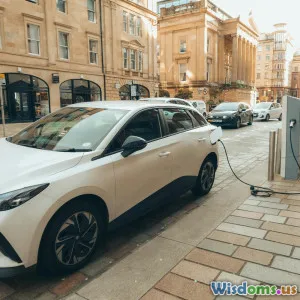
Hybrid vs Plug In Hybrid Cars: Which Is Best for Urban Commuters?
11 min read A detailed comparison of hybrid and plug-in hybrid cars, evaluating which suits urban commuters best. (0 Reviews)
Hybrid vs Plug-In Hybrid Cars: Which Is Best for Urban Commuters?
Introduction
Urban commuting presents a unique challenge: balancing daily convenience, fuel efficiency, environmental impact, and cost. With air quality concerns and rising fuel prices, many city dwellers are rethinking their ride choices. Hybrid and plug-in hybrid vehicles have emerged as popular alternatives to conventional gasoline cars. But which one truly meets the needs of urban commuters? This article dissects the nuances between hybrid (HEV) and plug-in hybrid electric vehicles (PHEV) to help you make an informed decision.
Understanding the Basics: What Are Hybrid and Plug-In Hybrid Cars?
Hybrid Vehicles (HEVs)
Hybrids combine a traditional internal combustion engine with an electric motor powered by a battery. The battery charges automatically by harnessing energy during braking and from the engine itself — no external plugging required. A well-known example is the Toyota Prius, one of the earliest hybrid cars designed for fuel efficiency and reliability.
Plug-In Hybrid Vehicles (PHEVs)
Plug-in hybrids operate similarly TO HEVs, but crucially, their batteries are larger and can be recharged by plugging into an external power source like a home outlet or public charging station. This allows them to run exclusively on electric power for a specific range—typically between 20 and 50 miles—before switching to hybrid mode. Vehicles like the Chevrolet Volt (discontinued but still popular) and the Mitsubishi Outlander PHEV exemplify this class.
Key Factors Affecting Urban Commuters
Fuel Efficiency and Daily Range
In city driving, stop-and-go traffic means fuel consumption usually spikes in gasoline-only cars. HEVs manage this well by automatically switching between the engine and electric motor for greater efficiency. For example, the Toyota Prius can achieve up to 58 mpg in combined city/highway driving according to EPA estimates.
PHEVs, on the other hand, can cover the average urban commute distance completely on electric power. According to the U.S. Department of Energy, the average one-way commute is about 16 miles. With electric-only ranges often exceeding 25 miles, many drivers could perform daily commutes without consuming a gallon of gas. This means that for short trips, PHEVs offer zero tailpipe emissions and zero fuel cost.
Cost Considerations
Upfront costs for PHEVs are generally higher than HEVs due to their larger battery packs and complex drivetrain. For example, a base Toyota Prius (hybrid) can be found in the low $25,000 range, whereas PHEVs like the Toyota Prius Prime start around $28,000 to $30,000.
However, federal and local incentives can reduce prices substantially. The U.S. federal tax credit for PHEVs can range up to $7,500 based on battery capacity. Cities with clean air programs might add additional perks such as rebates or reduced toll fees.
On the flip side, savings come from reduced fuel consumption and potentially lower maintenance costs. The electric mode in PHEVs lessens wear on the gasoline engine. A study from Consumer Reports highlights that EVs and PHEVs often incur fewer mechanical failures compared to traditional vehicles.
Environmental Impact
For urban commuters concerned about air quality, PHEVs present a compelling case. Operating in electric mode produces zero tailpipe emissions, helping reduce smog and particulate pollution.
Still, the source of electricity matters. In cities where electricity is largely generated through renewable sources, the environmental benefit is significantly enhanced. Conversely, in regions dependent on coal-fired power plants, the overall emissions reduction is less dramatic but still notable compared to gasoline-only vehicles.
HEVs, while better than conventional cars, always burn gasoline and thus emit greenhouse gases consistently.
Practicality and Infrastructure
One major advantage of HEVs is their simplicity—they never require you to plug the vehicle in, making them highly practical for commuters living in apartments or places without easy access to chargers.
PHEVs demand disciplined charging to maximize their potential. Convenient home or public charging infrastructure is critical. Urban dwellers without private garages may struggle, though rapid growth in public infrastructure is bridging this gap.
Real-World Insights from Commuters
Jessica Martin, a New York-based marketing professional, drives a Toyota Prius Prime (PHEV). She shares: "I cover around 30 miles round-trip daily. I plug in at home, so most days I never use gas. But if I forget or go on weekend trips, the hybrid engine kicks in seamlessly. It's perfect for city life where public charging stations are sprouting up rapidly."
Similarly, Mark Gonzales, a Chicago commuter using the Honda Insight hybrid, appreciates its no-fuss operation: "Without worrying about charging, I get great mileage and never experience range anxiety. It's straightforward and ideal for my routine."
Summary Table of Differences
| Feature | Hybrid (HEV) | Plug-In Hybrid (PHEV) |
|---|---|---|
| Battery Charging | Regenerative and engine-powered | Can charge externally via plug-in |
| Electric-only Range | Usually negligible or none | Typically 20–50 miles |
| Price | Lower starting price | Higher upfront cost, offset by incentives |
| Fuel Efficiency | High, but always uses some gasoline | Potentially zero gasoline use for daily commute |
| Environmental Impact | Reduced emissions | Lowest emissions when powered by clean electricity |
| Infrastructure Need | None (gas stations only) | Requires charging infrastructure |
Conclusion: Which Is Best for Urban Commuters?
If your daily commute falls within the electric-only range of a plug-in hybrid and you have convenient charging access, PHEVs offer exceptional benefits — including dramatically reduced fuel costs, lower emissions, and a quieter ride. They also provide flexibility for longer trips with gasoline backup.
On the other hand, if you lack reliable charging options, prefer a lower initial investment, or seek simplicity, traditional hybrids present a compelling alternative with outstanding fuel efficiency and zero need to plug in.
In the rapidly evolving landscape of urban transportation, both technologies contribute meaningfully toward more sustainable and cost-effective commuting. As infrastructure grows and battery tech improves, PHEVs are poised to become even more attractive.
By carefully evaluating your commuting patterns, access to charging, budget, and environmental values, you can choose a vehicle that not only fits your lifestyle but helps drive the city towards a cleaner, smarter future.
Sources & Further Reading:
- U.S. Department of Energy, Fuel Economy Guide (https://www.fueleconomy.gov)
- Consumer Reports, Road Test Rankings for Hybrids and PHEVs (2019-2023)
- EPA Green Vehicle Guide
- Interviews with urban drivers on hybrid and PHEV ownership experiences
Rate the Post
User Reviews
Popular Posts



















